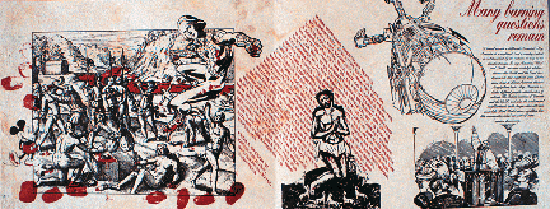 |
| MOVING PARTS PRESS fine art and literary publishing | |||
| 10699
Empire Grade : Santa Cruz, California 95060 fax 831 458-2810 : phone 831 427-2271 |
|||
CODEX ESPANGLIENSIS from Columbus to the Border Patrol
In this single spread, a type-metal cut by Posada depicts a priest pointing toward the heavens while frightened parishioners gape or turn away in horror. Rather than the metaphysical wrath of the divine, hovering above is some kind of rocket or missile drawn in the style found in recent science fiction comic books. Chagoya's substitution suggests that real danger lies in a military or technological assault on the lives and liberty of an unsuspecting and innocent population. In the center of the spread an image of Christ praying surrounded by howling coyotes or wolves symbolizes, perhaps, a kind of cultural entrapment or the sufferings encountered in border crossing (coyote is the name given those who are paid to help others to cross the US-Mexican border). The text announces "Many Burning Questions Remain” and is followed by Gómez-Peña's ruminations on the future relationship of the United States to Mexico after the advent of NAFTA, positing a new image of "America" which is not limited to the United States. He writes "In my America 'West' and 'North' are mere nostalgic abstractions—the South and the East have slipped into their mythical space. Quebec seems closer to Latin America than its Anglophone twin.” Here traditional geography is rewritten in order to more clearly map the cultural parallels that exist beyond its scope. On the far left of the spread a reproduction of a sixteenth-century engraving attributed to the publishing firm of Theodor de Bry depicts the painful torture and murder of a pre-Hispanic population, while Mickey Mouse smiles gaily from the margin. National power and super power are here conflated in the action hero Spider-Man who sports the head of George Washington to "oversee” the scene of historical destruction. In the context of this juxtaposition, Gómez-Peña's text is ominous: "Whether we like it or not, a new era has begun, and a new economic and cultural topography has been designed for us." What is clear from both text and image is that having one's economic and geographical topography designed by powers beyond one's control is precisely the experience of the oppressed populations in the Americas. The Codex Espangliensis suggests that today the results of this topographical project are just as brutal as in the past, but the methods have taken on a new, commercial and technological form. |
